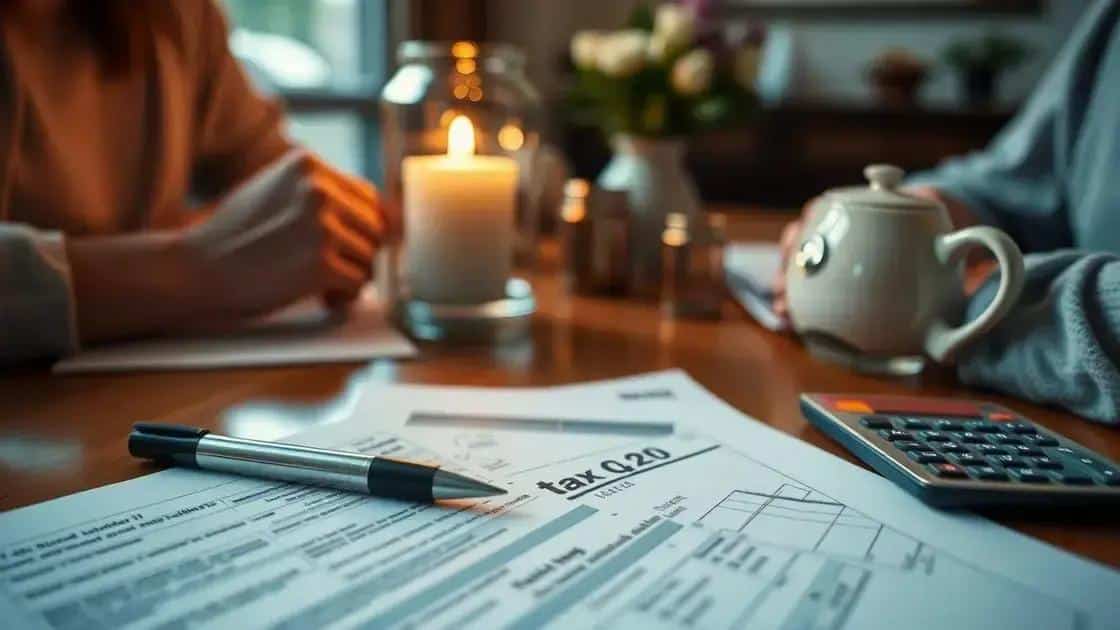Dinner tax saving strategy: your guide to saving big

The dinner tax saving strategy allows you to deduct 50% of eligible business meal expenses, provided you document the purpose, attendees, and keep necessary receipts for tax compliance.
Dinner tax saving strategy is essential for those looking to reduce expenses while enjoying a meal out. Have you wondered how dining out can fit into your budget? In this article, we will explore effective ways to leverage dining expenses to your advantage.
Understanding dinner tax deductions
Understanding dinner tax deductions is crucial for anyone wanting to make the most of their meal expenses. When you dine out for business purposes, much of that cost may be deductible. This means your meals can contribute to lowering your taxable income.
What Qualifies for Dinner Tax Deductions?
Not every meal is tax-deductible. To qualify, the meal must be directly related to your business activities. For example, if you take a client out to dinner to discuss a potential contract, that dinner is likely deductible.
- Meals with clients or business partners.
- Meals consumed during business trips.
- Company-wide events that include meals.
- Meals for employees at the workplace.
To take advantage of dinner tax deductions, it’s essential to keep accurate records. Receipts are paramount. Additionally, noting the purpose of the meal and the attendees can support your claims if questioned by the IRS. Each deduction reduces your overall taxable income, which ultimately saves you money.
How to Document Your Expenses
Your ability to claim these deductions depends on how well you document your meals. Always save itemized receipts and jot down the details of the meal’s business purpose. This documentation not only helps for tax preparation but also serves as a safety net should you face an audit.
Consider using a dedicated notebook or an app to record your meals and relevant details. This ensures you have a comprehensive history to rely on during tax season. Meal costs can add up quickly, making it even more vital to leverage every possible deduction.
How to document your dining expenses
Knowing how to document your dining expenses is essential for maximizing your tax deductions. Keeping accurate records not only simplifies the process but ensures you meet all tax requirements. By staying organized, you can reduce your stress during tax season and potentially save money.
Key Elements to Record
When documenting your expenses, there are four key elements to include. By capturing these aspects, you create a solid foundation for claiming deductions:
- The date of the meal.
- The amount spent.
- The purpose of the meal.
- The individuals present.
Each of these elements plays a crucial role in substantiating your claims. For instance, if you take a client to dinner, note not only the cost but also the reason for the meeting and who attended. This information can help avoid issues if the IRS questions your deductions.
Organizing Your Receipts
Receipts are the backbone of your expense documentation. It’s vital to keep them safe and organized. You can store them in a designated folder, or use digital tools to scan and save them electronically. Many apps allow you to categorize receipts for easy retrieval.
Consider using a spreadsheet to track your dining expenses. Input the date, amount, purpose, and attendees, which makes it easier to visualize your spending and provide a clear record for tax time.
Additionally, keep in mind that meals that are 50% deductible must be clearly identified in your records. This includes noting the business purpose and who was involved in the meal.
Maximizing business meals for tax benefits

Maximizing business meals for tax benefits can significantly increase your savings. When done correctly, these meals not only foster relationships but can also reduce your taxable income.
Understanding the Deduction Limits
To maximize your deductions, it’s essential to understand the limitations. Generally, you can deduct 50% of the meal costs that are directly tied to business. This means you need to ensure the meals are necessary and ordinary in your line of work.
- Only meals that involve business discussions are eligible.
- Keep in mind that lavish or extravagant expenses may raise flags.
- Documenting the business purpose is crucial.
- Consider using the standard meal allowance method for easy calculations.
For example, if you spend $100 on a meal with a client, you can only deduct $50 when filing your taxes. This is why documenting is vital—as it justifies your claims and ensures you’re complying with IRS rules.
Choosing the Right Restaurants
The venue can also influence the tax benefits. Choosing restaurants that cater to business professionals can boost the credibility of your meal expense claims. Opt for venues known for their comfortable atmosphere that allows for business discussions. Think about restaurants that provide a good balance of price and quality to support your deductions.
By consistently making smart choices about your dining venues, you can ensure that you remain on the right side of tax regulations while still enjoying meals with clients and partners.
Tips for meeting with clients over dinner
Meeting with clients over dinner can be a powerful way to strengthen relationships and discuss business. To ensure these meetings are productive and enjoyable, consider a few key tips.
Choosing the Right Setting
The location of your dinner meeting matters significantly. A quiet, comfortable restaurant allows for better conversation. Look for places that provide a relaxed atmosphere. This helps put everyone at ease, making discussions more open and friendly.
- Avoid noisy restaurants that can disrupt conversation.
- Choose a venue that offers your client’s preferred cuisine.
- Consider a location that’s convenient for both parties.
- Look for restaurants with privacy for business discussions.
By selecting an appropriate setting, you set the stage for better communication and relationship building.
Prepare Your Agenda
Having a clear agenda for the meeting helps keep discussions focused. Outline the topics you want to cover, and be ready to adjust based on how the conversation flows. This balance between structure and flexibility can create a productive meeting.
Preparing questions in advance can guide the conversation. Moreover, showing genuine interest in the client’s thoughts can lead to deeper connections. Listening actively while dining shows you value their input.
Be Mindful of the Bill
When it comes time to pay, it’s essential to approach the bill correctly. Always be discreet and avoid any awkwardness. Express that you would like to treat them, and if the guest insists on splitting, be flexible. This generosity can leave a positive impression.
Documenting the meal as a business expense can provide tax benefits, so ensure you keep the receipt for your records. By making the meal enjoyable and practical, you can enhance the chances of a successful business relationship.
Common mistakes to avoid with tax deductions
When it comes to claiming tax deductions, especially for meals, there are common mistakes that many make. Avoiding these pitfalls can save you time and money.
Not Keeping Receipts
One of the biggest mistakes is failing to keep receipts. Without receipts, proving your expenses becomes challenging. Always save itemized receipts for every deductible meal. This simple habit supports your claims and can be crucial if the IRS decides to audit your deductions.
- Always request and save receipts when dining out.
- Organize them by month or category for easy access.
- Consider using an app to store electronic copies.
- Label receipts with the date and business purpose.
By properly organizing receipts, you simplify the tax filing process and reduce the risk of errors.
Ignoring the Business Purpose
Another frequent error is neglecting to document the business purpose of the meal. It’s not enough to simply dine out; you must show that the meal was directly related to business. This means writing down who was present and the topics discussed.
For instance, if you meet a client to discuss a project, note this information. This record legitimizes your deduction and protects you from potential scrutiny.
Overly Lavish Expenses
Claiming extravagant expenses is a red flag for audits. Meals that appear overly lavish can lead to disallowed deductions. The IRS looks for deductions that seem unreasonable compared to the business conducted.
Stick to moderate dining options that reflect the nature of the business interaction. This helps ensure that your expenses are viewed as reasonable and necessary.
Failing to Track Changes in Tax Law
Tax laws can change frequently. Not staying updated can lead to missed opportunities or mistakes in your deductions. Regularly review tax guidelines related to meal deductions or consult a tax professional when uncertain.
Being aware of the latest tax regulations helps you maintain compliance and maximize your deductions effectively.
FAQ – Frequently Asked Questions about Dinner Tax Deductions
What qualifies as a deductible business meal?
A business meal qualifies for deduction if it is directly related to your trade or business and you keep proper documentation.
How much of my meal expenses can I deduct?
Generally, you can deduct 50% of the meal costs that are directly associated with business activities.
What should I do if I lose my receipts?
If you lose receipts, try to reconstruct the details using bank statements or credit card statements, but it’s best to keep everything organized to avoid this issue.
Are meals with employees also deductible?
Yes, meals provided to employees for business purposes, such as meetings, can also be deductible, provided you keep the records.






